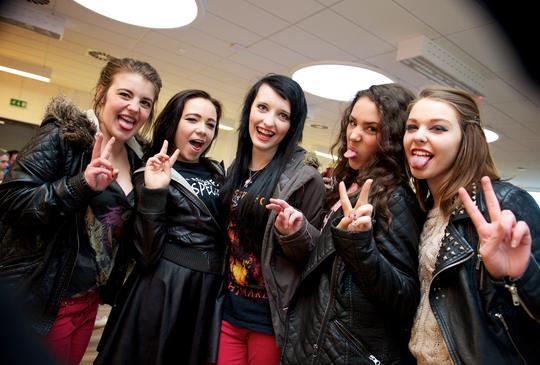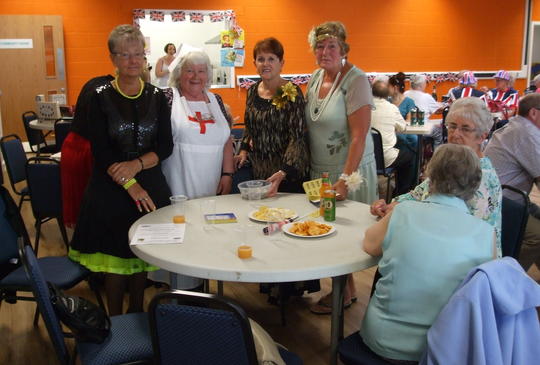
Peak Valley Housing Association: Opening Up The Hub
Peak Valley Housing Association is a non-profit-making charitable organisation that provides and manages social housing in the Hattersley and Mottram area of Tameside for people who need low-cost housing. The Association has approximately 1500 homes and works closely with its tenants, other residents and public sector bodies on various community matters. In 2012 it opened a new community centre, The Hub, on Stockport Road, providing purpose-built facilities for its Housing and Neighbourhood Team, Tameside Metropolitan Borough Council, the Neighbourhood team of Greater Manchester Police, Manchester Credit Union, Hattersley Youth Club and Hattersley Community Forum.
Sam Cooper is the Association’s Community Investment Officer and a member of its Housing and Neighbourhood Team. I’ve arranged to meet him here at The Hub to discuss his work and the value of the new centre to the local community. The English indices of deprivation rank the area in the 10% most deprived in England and I want to know what difference The Hub can make. We’re sat in one of the new meeting rooms overlooking Hattersley. The sun is shining. The room is light and fresh. It’s a pleasant space, I think. I start by asking him to explain what he does and why his work is important.
His role, he says, is to work with the Association’s Housing and Neighbourhood Team, with partner organisations – including organisations outside The Hub, such as local schools, churches and private developers – with its tenants, with other community groups and with the wider community in the area to find opportunities for joint investment – “a community activity or a community project” – and then use the Association’s data to target people in the community who might benefit from the activity or the project.
He gives me some examples. “Barratt Homes are going to ring-fence a number of apprenticeships to local people. So we’re targeting households with people who are more likely to go for them. We also targeted a pocket of the estate for a Health, Wealth and Well-Being programme last summer. And we often take a double decker bus with people from various agencies - including the Citizens Advice Bureau, the Council, housing teams, etcetera - park it in different places, knock on doors and invite people to come to The Hub for a chat about issues. Or we’ll ask partners to supply a couple of staff to do mock interviews with school leavers and provide feedback. ”
Why is this important? There are a lot of reasons, he says. But it can be boiled down to commercial interest. “Will somebody be more likely to pay their rent if we’ve helped to improve their well-being? Or will somebody who we’ve managed to work with to achieve employment, not relying on welfare benefit, be more likely to stick a tenancy out?”
I suggest that this is about corporate social responsibility (CSR) and he agrees, “Yeah, I think so, yeah”, adding that some people are suspicious of their motives and those of their partners: “Why is my landlord getting involved in this kind of thing? This isn’t their responsibility.”
But he’s keen to point out that community investment is an integral part of the business, of the culture of the organisation, and not just for show, explaining that they’ve “always been very partnership oriented” and that their relationship with the council is particularly strong – “we share a lot of information on a daily basis… our community investment strategy mirrors their local neighbourhood plan… we’re jointly managing employability training with the council.”
I wonder whether suspicions about the Association’s motives have been heightened by its sale of land to private housing developers, Barratt Homes, and to Tesco, for the construction of a massive supermarket in the area. He responds by pointing out the community value. “The reason for selling that land”, he explains, “was to pay for property improvements across their estate – rewiring, new kitchens, new bathrooms, new boilers – and to construct this hub.”
The Hub was a much needed investment, he continues. “We [the partners] had separate facilities in the old precinct - a community centre, a library, a police station and a council office, a number of shops – and they were very dated, not fit-for-purpose. The partnership had been working well for Hattersley and Mottram and we felt that working together in one building would only improve that more. And the move means that we’ve got a huge piece of land for residential development.”
I ask Sam to explain how The Hub will help the partnership to support the community. What’s the thinking behind it? “Well,” he says, “it’s a place where residents can come in and get information on local services, take part in community activities, access Council services and Peak Valley services, get help with credit issues, police issues... join groups like Zest, who meet here once a week on Friday and help people with mental health issues, like mild depression, or health issues that are affecting their mental well-being. Or they can just come in and have a cup of tea and then stay in the cafe.” The space is good for them and it’s good for the community, he suggests.
Ultimately it’s about getting people used to coming here and using the facilities. Some people say it’s great, some say the community spirit has been lost slightly and others we haven’t seen since the move. But it’s got a lot of potential.
Bringing the partners together adds value to their services, he adds. “The community groups could find alternative venues because there are a lot of church halls and other spaces in the area. But I think having those groups dispersed across the estate would mean that we couldn’t work together as well and they couldn’t work together as well. So, for example, the Community Forum, which is an umbrella organisation for about 12 community groups in the area, provides its members with advice and support on funding applications. It’s easier for them to do that here.”
It’s been a quiet morning in The Hub, so I ask about footfall. “It’s picking up”, he says. “It was difficult at first, until we realised that Greater Manchester Police had put their sign on the front of the building.” He laughs. “People thought it was a police building. So we’ve put our Peak Valley Housing sign outside instead and we’re promoting all of the things that go on here.”
It was difficult at first, until we realised that Greater Manchester Police had put their sign on the front of the building.
“Ultimately it’s about getting people used to coming here and using the facilities”, he explains. “Some people say it’s great, some say the community spirit has been lost slightly and others we haven’t seen since the move. But it’s got a lot of potential. The quality of the actual building and its facilities helps. We can use it for quality projects and quality activities. And the location is better here because it’s more central to Hattersley and Mottram – the old facilities were in the centre of Hattersley.”
So what are the main challenges now in realising that potential? “Well, one of the simpler challenges is to make the place look less clinical. Community spaces normally have pieces of artwork on show, photographs, you know. We need to make the space more personable to local people.”
One of the simpler challenges is to make the place look less clinical. Community spaces normally have pieces of artwork on show, photographs, you know. We need to make the space more personable to local people.

“We’d also like to get more young people involved in using the community facilities”, he says. “We have a youth group; but there’s a gap between that group and the Forum, which is generally run by and for over-50s groups. Having younger people involved would be good for The Hub and for the Forum, in terms of future-proofing.”
“There are gaps in the timetable as well. So we want to make sure those are filled with meaningful activities. That includes doing some research into how those gaps could be filled in, what the need is really. Part of that is to help increase our portfolio even further. There’s the potential for weekend and evening activities as an income generator for the Forum and the partners and as an affordable community service – for things like christenings, wedding reception, parties.”
Sam’s convinced me that The Hub will become a useful and meaningful community space for many residents in the area. But, later, as I make my way to the station, past the old facilities, I get a better sense of the footfall challenge. It’s a long walk down to the bottom of Hattersley and a long walk up to The Hub. That would take some getting used to, I think.
For further information on Peak Valley Housing Association and The Hub, go to www.pvha.co.uk
This interview is part of Realising the Potential of Community Hubs, a Greater Manchester Local Interaction Platform project.
Making people laugh: Brinnington Community Association, Stockport
Contributed by Alex Wharton
The Mosses Community Association: Managing The Community’s Centre
Contributed by Alex Wharton
Contributor Profile
Alex is a Researcher at the Centre for Sustainable Urban and Regional Futures (SURF). He is currently working full-time on the Greater Manchester Local Interaction Platform (GM LIP), one of 5 LIP set up by Mistra Urban Futures, an international centre for sustainable urban futures, based in Gothenburg. His main interest is in the socio-economics of sustainable urban transitions - specifically, the relationship between economic growth and social justice, and the ways in which local authorities engage with local communities.





